Related Research Articles
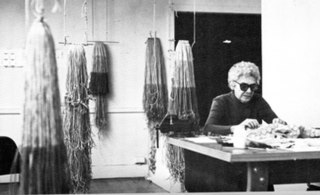
Claire Zeisler was an American fiber artist who expanded the expressive qualities of knotted and braided threads, pioneering large-scale freestanding sculptures in this medium. Throughout her career Zeisler sought to create "large, strong, single images" with fiber. Zeisler's non-functional structures were constructed using traditional weaving and avant-garde off the loom techniques such as square knotting, wrapping, and stitching. Zeisler preferred to work with natural materials such as jute, sisal, raffia, hemp, wool, and leather. The textiles were often left un-dyed, evidence of Zeisler's preference for natural coloration that emphasized the fiber itself. When she used color, however, Zeisler gravitated towards red.

Olga de Amaral is a Colombian textile and visual artist known for her large-scale abstract works made with fibers and covered in gold and/or silver leaf. Because of her ability to reconcile local concerns with international developments, de Amaral became one of the few artists from South America to become internationally known for her work in fiber during the 1960s and ‘70s. She is also considered an important practitioner in the development of postwar Latin American Abstraction. She currently lives and works in Bogotá, Colombia.
Regis Brodie is a tenured Professor of Art at the Department of Art and Art History at Skidmore College in Saratoga Springs, NY and a potter. Since 1972, he has been serving as the Director of the Summer Six Art Program at Skidmore College. He also wrote a book called The Energy Efficient Potter which was published by Watson-Guptill Publications in 1982. He started the Brodie Company in 1999 in the interest of developing tools which would aid the potter at the potter's wheel.
Mary Lee Hu is an American artist, goldsmith, and college level educator known for using textile techniques to create intricate woven wire jewelry.
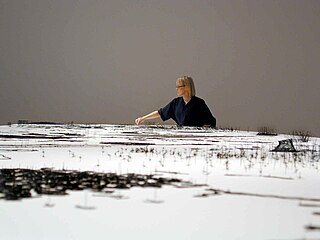
Anne Wilson is a Chicago-based visual artist. Wilson creates sculpture, drawings, Internet projects, photography, performance, and DVD stop motion animations employing table linens, bed sheets, human hair, lace, thread and wire. Her work extends the traditional processes of Fiber art to other media. Wilson is a professor in the Department of Fiber and Material Studies at The School of the Art Institute of Chicago.

Nick Cave is an American fabric sculptor, dancer, and performance artist. Cave's family was large in size and always supportive of his artistic interests. He claims his upbringing gave him an artistic attentiveness to found objects and assemblages. Cave started his artistic journey by manipulating fabrics from older sibling's hand-me-downs. After he graduated from Hickman High School in 1977, he enrolled in the Kansas City Art Institute where he finished a Bachelor of Fine Arts in 1982. He is best known for his Soundsuits – wearable fabric sculptures that are bright, whimsical, and other-worldly. He also trained as a dancer with Alvin Ailey. His later sculptures focused on color theory, mixed media, and large-scale installations. He currently resides in Chicago, Illinois, and is director of the graduate fashion program at the School of the Art Institute of Chicago. He still continues to work on Soundsuits as well as works completed as a sculptor, dancer, and performance artist.
Sonya Clark is an American artist of Afro-Caribbean heritage. Clark is a fiber artist known for using a variety of materials including human hair and combs to address race, culture, class, and history. Her beaded headdress assemblages and braided wig series of the late 1990s, which received critical acclaim, evoked African traditions of personal adornment and moved these common forms into the realm of personal and political expression. Although African art and her Caribbean background are important influences, Clark also builds on practices of assemblage and accumulation used by artists such as Betye Saar and David Hammons.
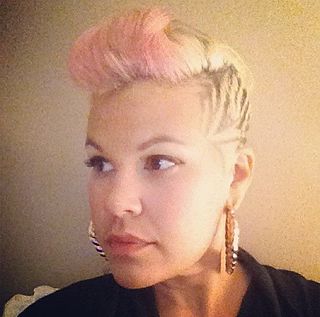
Heather T. Hart is a visual artist who works in a variety of media including interactive and participatory Installation art, drawing, collage, and painting. She is a co-founder of the Black Lunch Table Project, which includes a Wikipedia initiative focused on addressing gender gap and diversity representation in the arts on Wikipedia.
Harmony Hammond is an American artist, activist, curator, and writer. She was a prominent figure in the founding of the feminist art movement in 1970's New York.
Cristina Córdova is an American-born, Puerto Rican sculptor who works and lives in Penland, North Carolina.
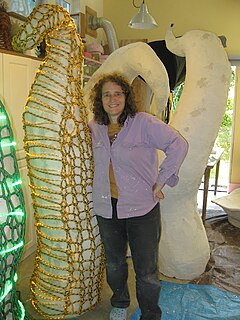
Carol Milne is an internationally recognized Canadian American sculptor living in Seattle, Washington. She is best known for her Knitted Glass work, winning the Silver Award, in the International Exhibition of Glass Kanazawa Japan 2010.
Polly Barton is an American textile artist.

Joyce J. Scott is an African-American artist, sculptor, quilter, performance artist, installation artist, print-maker, lecturer and educator. Named a MacArthur Fellow in 2016, and a Smithsonian Visionary Artist in 2019, Scott is best known for her figurative sculptures and jewelry using free form, off-loom beadweaving techniques, similar to a peyote stitch. Each piece is often constructed using thousands of glass seed beads or pony beads, and sometimes other found objects or materials such as glass, quilting and leather. In 2018, she was hailed for working in new medium — a mixture of soil, clay, straw, and cement — for a sculpture meant to disintegrate and return to the earth. Scott is influenced by a variety of diverse cultures, including Native American and African traditions, Mexican, Czech, and Russian beadwork, illustration and comic books, and pop culture.
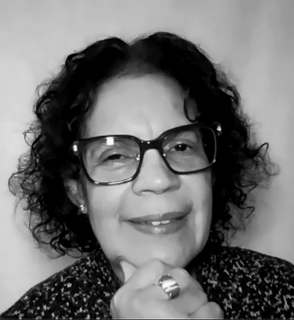
Candida Alvarez, was born in Brooklyn, New York, in 1955. She is an American painter and a tenured professor of Painting and Drawing at the School of the Art Institute of Chicago where she has taught since 1998.

Helena Hernmarck is a Swedish tapestry artist who lives and works in the United States. She is best known for her monumental tapestries designed for architectural settings.
Françoise Grossen is a textile artist known for her braided and knotted rope sculptures. She lives and works in New York City. Grossen’s work has been acquired by the Metropolitan Museum of Art, New York; the Renwick Gallery, Smithsonian American Art Museum, Washington, DC; and the State Hermitage Museum, Saint Petersburg, Russia.

Firelei Báez is a Dominican artist who lives and works in New York City. Báez makes intricate works on paper and canvas as well as large scale sculpture.
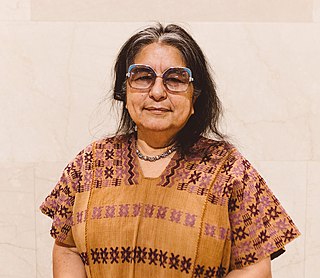
Consuelo Jiménez Underwood is an American fiber artist, known for her pieces that focus on immigration issues. She is an indigenous Chicana currently based in Cupertino, California. As an artist she works with textiles in attempt to unify her American roots with her Mexican Indigenous ones, along with trying to convey the same for other multicultural people.
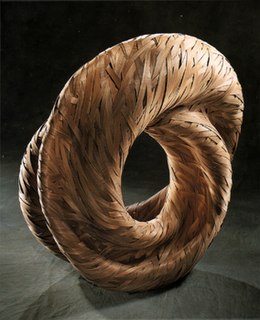
Barbara Cooper is an American artist whose practice encompasses abstract sculpture, public and installation art, drawing and set design. She is most known for her sculpture, which emphasizes process, handcraft, and its basis in natural forms and processes of transformation, such as growth, protection and regeneration. Critic Polly Ullrich writes that "Cooper's hand-intensive art is an art of condensation" that takes "the flow of time and growth as a subject"; that quality often leads writers to align Cooper with postminimalism. John Brunetti describes her work as "sinuous, tactile sculptures [that] quietly juxtapose conceptual and formal dichotomies, among them the organic and man-made, the feminine and the masculine, movement and stasis."
Joan Schulze is an American artist, lecturer, and poet. Schulze's career spans over five decades: she is best known for her work of contemporary quilts, fiberarts, and collage. Schulze has been named a “pioneer of the art quilt movement,” and her influence has been compared to that of Robert Rauschenberg’s. Her work is in galleries and private collections worldwide including the Renwick Gallery/Smithsonian Institution in Washington DC, the Museum of Arts and Design in New York, & the Oakland Museum of California.
References
- 1 2 Heller, Jules; Heller, Nancy (2013). North American women artists of the twentieth century a biographical dictionary. New York: Routledge. ISBN 9781315051680. OCLC 1086457528.
- ↑ "Joan Livingstone Biography – Joan Livingstone on artnet". www.artnet.com. Retrieved 2019-09-06.
- ↑ Craig, Gerry; Livingstone, Joan; Elkins, James; Yood, James (2002). Joan Livingstone. Winchester, England: Telos Art Pub. ISBN 1902015274. OCLC 49829083.
- 1 2 "Joan Livingstone: Spine, 1995". www.metmuseum.org. Retrieved 2019-09-06.
- ↑ Parsons, Joel. marvels and oddment(s). Rhodes College.
- ↑ Koplos, Janet; Metcalf, Bruce (2010). Makers : a history of American studio craft. Chapel Hill: University of North Carolina Press. ISBN 9780807895832. OCLC 658203695.
- ↑ "Joan Livingstone: Oddment[s] - John Michael Kohler Arts Center". www.jmkac.org. Retrieved 2019-09-10.
- ↑ McConnell, Sharon (2006). Joan Livingstone: Membranes, Margins, Disruptions (PDF). Fosdick-Nelson Gallery – via joanlivingstone.com.
- ↑ "Joan E. Livingstone". The Art Institute of Chicago. Retrieved 2019-09-06.
- ↑ "2005-6 Annual Report, Boise Art Museum" (PDF). Boise Art Museum. 2006.
- ↑ "Honolulu Museum of Art » Loomless: Contemporary Fiberworks from the Museum's Collection". honolulumuseum.org. Retrieved 2019-09-06.
- ↑ "Materials for Volunteer Docents :: The Dennos Museum Center". www.dennosmuseum.org. Retrieved 2019-09-06.
- ↑ "Mace". www.dia.org. Retrieved 2019-09-06.
- ↑ "Joan Livingstone". MCA. Retrieved 2019-09-06.
- ↑ Archives, Vital. "Thoroughly Modernist Museum". Urban Milwaukee. Retrieved 2019-09-06.
- ↑ Koplos, Janet; Metcalf, Bruce (2010-07-31). Makers: A History of American Studio Craft. Univ of North Carolina Press. ISBN 9780807895832.
- 1 2 "Joan Livingstone". American Craft Council. Retrieved 2019-09-06.
- ↑ "Faculty". School of the Art Institute of Chicago. Retrieved 2019-09-06.
- ↑ Grace, Paul (2008-11-01). "Book Review: The Object of Labor: Art, Cloth and Cultural Production, Joan Livingstone and John Ploof (eds)". Textile: The Journal of Cloth and Culture. 6 (3): 340–344. doi:10.2752/175183508X377681. ISSN 1475-9756. S2CID 192106342.
- ↑ Koslin, Désirée (2009-12-01). "Joan Livingstone and John Ploof, eds., The Object of Labor: Art, Cloth, and Cultural Production". Winterthur Portfolio. 43 (4): 422–423. doi:10.1086/649122. ISSN 0084-0416. S2CID 225086163.
- ↑ admin. "Review of 'The Object Of Labor: Art, Cloth & Cultural Production' | The Journal of Modern Craft" . Retrieved 2019-09-07.
- ↑ Doy, Gen (May 2008). "Review: The Object of Labor Art, Cloth, and Cultural Production by Joan Livingstone and John Ploof (Eds)". The Art Book. 15 (2): 78. doi:10.1111/j.1467-8357.2008.00966_9.x. ISSN 1467-8357.
- 1 2 "Joan Livingstone: Oddment[s] - John Michael Kohler Arts Center". www.jmkac.org. Retrieved 2019-09-06.
- ↑ "Joan Livingstone: marvels and oddment(s) | Rhodes Sites". sites.rhodes.edu. Retrieved 2019-09-06.
- ↑ "Joan Livingstone". The Laura Russo Gallery.
- ↑ Carney, Margaret; Groot, Candice, eds. (2002). Visual perspectives: fourteen years of the Virginia A. Groot awards. Chicago, IL: Virginia A. Groot Foundation. OCLC 51340811.
- ↑ Miro, Marsha (November 2002). "Joan Livingstone at the Evanston Art Venter". Art in America. 90 (11): 164. ISSN 0004-3214.
- ↑ Ulrich, Polly (August–September 2000). "Jane Lackey/Joan Livingstone". American Craft. 60 (4): 70–71. ISSN 0194-8008.
- ↑ "Jane Lackey". cranbrookart.edu. Retrieved 2019-09-06.
- ↑ Embodiment: Annet Couwenberg, Joan Livingstone, Christine LoFaso, Mark Newport, April 18 - May 30, 1999. Arkansas Arts Center, Decorative Arts Museum. 1999.
- ↑ "Limits of Capacity" (PDF). Joan Livingstone.
- ↑ "Publications and Catalogs - NIU - Art Museum". Northern Illinois University. Retrieved 2019-09-06.
- ↑ Artemisia Gallery, ed. (1993). XX: twentieth anniversary, 1973-1993: Artemisia Gallery. Chicago: The Gallery. OCLC 35652972.